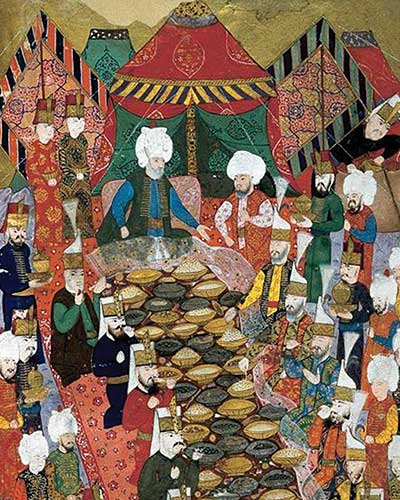Agora Open Air Museum
- 18 Nov - 24 Nov, 2017

Medieval Muslims, like many others, ate according to seasonal influences. Typical winter meals used vegetables such as sea kale, beets, cauliflower, turnips, parsnips, carrots, celery, peas, broad beans, lentils, chickpeas, olives, hard wheat, and nuts. These were usually eaten with meat dishes. Deserts usually consisted of dried fruits such as figs, dates, raisins, and prunes. The fruits were accompanied by drinks made from syrups of violet, jasmine, aloe, medicinal spices, fruit pastilles, and gums.
By contrast, their summer diet consisted of 11 types of green beans, radishes, lettuces, chicory, aubergines, carrots, cucumbers, gherkins, water-cress, marrow, courgettes, and rice. The meat accompanying these was mainly poultry, ostrich, and beef. Desserts included fruits such as lemon, lime, quinces, nectarines, mulberries, cherries, plums, apricots, grapes, pomegranates, watermelon, pears, apples, and honeydew melon. Drinks were made from syrups and preserves of fruit pastilles, lemon, rose, jasmine, ginger, and fennel.
This banquet of food was presented on a table cloth, the concept of which was spread in Andalusia by Ziryab. He also changed the heavy metal drinking goblets and gold cups used on the dinner tables of the Cordoban court to delicate crystal.
In most European aristocratic circles, the demand for Asian recipes and spices increased rapidly. Sources from the chronicles of the pope in Avignon in the 14th century tell us that ships from Beirut brought jams, preserves, rice and special flour for making cakes, plus compensatory laxatives. Queen Christina of Denmark took care to follow the Muslim diet and imported their products and fruits. Since Denmark could mostly supply apples and rye, it is perhaps “food for thought” to consider the origin of Danish pastries.
Crystal was developed in Andalusia due to the ingenuity of other Muslims. Most of the Andalusian rock crystal pieces that have survived are found in European churches and monasteries, the most famous among them being a spherical bottle currently in the Astorga Cathedral, Spain. It bears vegetal patterns and a Kufic inscription, the common decorative elements on rock crystal pieces.
As well as introducing crystal that was used for drinking glasses, Abbas ibn Firnas was the same man who used glass in a most ingenious way to construct a planetarium, supplying it with artificial clouds, thunder, and lightning.
Muslim potters then introduced the art of stylish dining with a variety of ceramics and glazes. Malaga and Valencia were major centres of the industry, and Muslims revolutionised the production and decoration of pottery through their use of lustre glaze.
Both Valencian and Malagan potters exported their wares to Christian-populated regions like northern Spain, southern France and Italy. Here, Malagan potters were thought to have laid the foundations of the famous Majolica ware, which went on to dominate the Italian ceramic industry.
COMMENTS